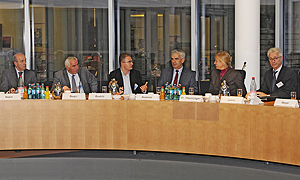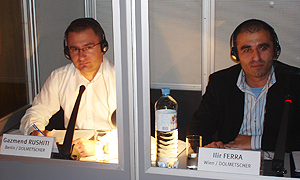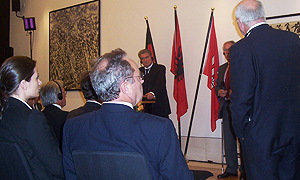Regarding the always growing network of international politics, economy, science, culture and media, the conference interpreter is a bridge of communication between the numerous languages and cultures that are to be found when different delegations meet.
We have a wide network of consecutive and whisper interpreters as well as interpreters for negotiations that choose the kind of interpreting that seems the most meaningful in that moment / regarding the cases.
As far as media goes, they can hardly exist now without qualified interpreters. Indeed we want to take part in every event happening in the world, no matter where it is happening. That’s where the work of the interpreter starts: he ensures impeccable communication between nations, worldwide.
Some advice for organizations that need to recruit conference interpreters
In the international meetings the success depends clearly on the quality of the interpretation. The following pieces of advice answer basic questions about the recruitment of conference interpreters and are meant to enable you to create a good communication.

1. Different interpreting techniques
There are basically four different interpretation techniques:
Simultaneous interpreting
The interpreters sit in a soundproof cabin and convey simultaneous the words of the speaker into the target language. Simultaneous interpreters can be employed for big manifestations, conferences with two or more languages as well as for congresses for which consecutive interpretation produces too many delay. Since the simultaneous interpretation requires very intensive concentration, interpreters work in teams of two or three to replace each other every 20-30 minutes. Thus, one must disposed of a large number of interpreters.
Consecutive interpreting
By consecutive interpreting the text is translated just after the original speech. Consecutive interpreting is relevant for relative short interventions (for example during workshops) or for negotiations, during which the presence of the interpreter in the negotiation place very important is. In comparison to simultaneous interpreting lasts the intervention by consecutive interpreting the double for each target language.
Whisper interpreting
By whisper interpreting, the interpreter speaks at the same time that the speaker but don’t use any technical mean. The use of the whisper interpretation is relevant by accompaniment for small groups, for example by factory visits, but this technique cannot replace the simultaneous interpreting, since original speaker and interpreter speak at the same time in the same place and produce so inevitably disturbing effects. Since whisper interpreting requires as much or maybe more concentration than simultaneous interpreting, two interpreters for each language are needed during long-lasting manifestations.
Negotiation interpreting
By negotiation interpreting shorter text passages are interpreted afterwards and sometimes partially.
2. The recruitment of conference interpreters
Since the name of the profession is not protected, the employment of conference interpreter must go with a lot a precaution. Skilled interpreters are generally free lancers employed on contracts. It is generally better for the organizer to put an interpret consultant in charge to the employment of the interpreter team. He knows how many interpreters have to be engaged, will make a quote and enroll the interpreters in the name of the organizer and according to the needs of the event.
Furthermore, an interpreter consultant knows the technical installations needed for the interpretation and is able to provide information documents for the interpreters or could help them doing that. He is the contact person of the organizer about every enquiry concerning the interpretation and he is the connecting person within the interpretation team. The interpretation agency Rushiti is every time for you available if you have any questions about this.
3. Planning for the employment of the interpreters
An interpreter consultant should be employed from the very beginning of the organization of an international event. He is able to advise the organizer about the interpreting process und if need arises try to limit the unnecessary costs.
Conference interpreters have to be employed as soon as possible (sometimes several months before the event). Since the number of qualified interpreters is low in Germany, problems often occurs during the intensive conference months of spring and autumn or when rare languages are involved.
In the events simultaneously interpreted, the number of interpreter needed and the composition of the team depend on the number of conference languages, the number of parallel events, the lasting of the meetings, and the complexity of the themes. The teams have to be organized so that every language is interpreted in every target languages and that the interpreters don’t have to interpret indirect (by relaying) a text already interpreted in another language.
4. Technical installations for interpreting a conference
The installation for the interpreters have to match the norm ISO/DIS 2603 (for fixed cabins) or to the norm 4043 (for transportable cabins). The technical facilities of the conference have to fulfill the norm ENV 50185-1 or the norm CEI. The facilities have to be controlled during the event by a technical engineer.
The cabins have to be installed so that the interpreters are able to see the orator and the projection screens. The gests and the face expressions as well as the projected pictures are very as important for the interpreter as for the audience. Screens or monitors are at best a visual amelioration but can in no way replace the direct sight. Films or such presentations can only be interpreted if the interpreter saw the script before the event and if the sound is perfectly transmitted into the cabin. A record of the interpreted text can only be made if the interpreter has given his acceptance before and is generally not included in the contract signed by the interpreter.
5. Preparing the event
The interpreters have to prepare the technical themes evocated in the event. For that purpose they need background information about the organizer and the other participating organizations, the program, the agenda and possibly protocols and programs of previous events, and all documents that going to be given to the participants. The interpreter must have the list of the participants and all potentially available glossaries, for instance with the official translations of the names and the organs of the organizations. Insofar as the discourses and the interventions are prepared in writing by the orator, they have to be available for the interpreters so that they can work on it. Sometimes a previous briefing as well as participating in the orator conversations can be helpful for the interpreter.
The conference interpreters are compelled to keep every information in confidence.
6. Orator
The orators has to be asked by the organizer to send there written notes as soon as possible and the latest 2 weeks before the event to the interprets. It is better when it is written on the script if it is the final version or just a draft or if the orator has planned to speak without regarding his notes. Essential change in the read texts has to be mentioned to the interprets onsite.
Besides, when an orator speaks without reading or read his text, an adequate speaking speed is very important. For the texts that are for example interpreted from English into German, the interpreted version is often longer than the original text and required more time. An eye contact between orator and interpret is by the way preferable.
The simultaneous interpretation is only possible when the orator speaks in a turned-on microphone, since the cabins are sound-proof. The speakers who move back from the pulpit when they speak have to wear a transportable microphone. The organizer has to take care that a person in the auditorium specially takes care that the conference technique is good working.
Numbers and proper names have to be particularly distinctively pronounced. Abbreviations have to be avoided unless they are explained the first time they occur. Quotes, proverbs, play on words relaxed a discourse but they are hardly communicable.
7. After the event
When an event is finished, a debriefing about the interpreting intervention is recommended. After the conference, a short discussion is advisable between the organizer and the interpret consultant so they can discuss the potential amelioration of the organization. The quality of the work is better then and the client is satisfied.





